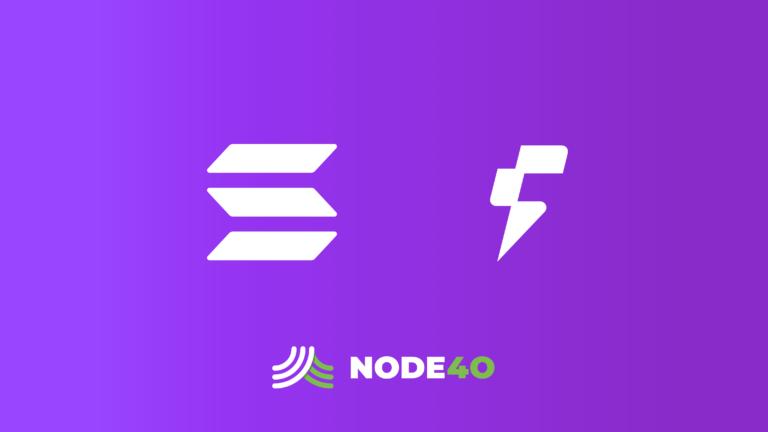The world of crypto investing is entering a new era. Over the past several months, global asset managers have been stampeding to file for spot Solana ETFs. What’s different this time isn’t just the desire to hold SOL as an asset, it’s that many of these proposed ETFs are looking to stake their Solana holdings to generate yield.
In theory, it’s the perfect marriage: the convenience and regulatory protection of an ETF, combined with the on-chain yield that makes Solana attractive to long-term holders. But as anyone familiar with Solana’s technical realities knows, staking SOL, and tracking the results, is anything but simple.
In this blog post, we’ll unpack why the coming wave of yield-bearing Solana ETFs faces enormous operational and regulatory reporting challenges. We’ll also explain why NODE40 is uniquely positioned to solve these challenges, and why no one else has built the necessary technology to deliver truly institutional-grade reporting for staking-enabled Solana products.
Solana ETFs: The New Frontier
Let’s start with the basics.
Over the last year, at least nine major issuers, including heavyweights like VanEck, Bitwise, Fidelity, and Grayscale, have filed S-1 registrations with the U.S. Securities and Exchange Commission (SEC) for spot Solana ETFs.
Unlike earlier crypto ETF products, these new filings often include explicit language about staking SOL directly on the Solana network. Issuers plan to delegate portions of the trust’s SOL to validators, thereby earning staking rewards that can be passed through to ETF investors as additional yield.
This is a big deal. It signals that institutional finance isn’t just looking to buy and hold crypto, they want to participate in crypto-native yield generation.
But there’s a catch: the second you move from simply holding SOL to actively staking it, you’re stepping into one of the most complex accounting environments in digital assets.
The Complexity Behind “Simple” Staking
At first glance, staking might seem straightforward. You lock SOL into a staking account, earn rewards every few days, and withdraw those rewards when needed.
If only it were that simple.
Solana’s proof-of-stake architecture introduces considerable complexity for anyone attempting to manage large-scale staking operations, particularly institutions subject to stringent financial reporting requirements.
Here’s why:
Stake Accounts Multiply Rapidly
When you stake SOL, the network doesn’t simply tie it to your wallet address. Instead, it sets up separate stake accounts behind the scenes. Each stake account is a unique on-chain entity with its own life cycle:
- Activation
- Delegation to a validator
- Deactivation (when you choose to unstake)
- Withdrawal
For a large asset manager staking tens of millions of dollars in SOL, this could result in dozens or even hundreds of stake accounts.
These accounts might all be tied to the same wallet owner, but tracking them requires custom logic. Solana’s blockchain doesn’t natively expose a “master list” of all stake accounts linked to a specific fund or authority.
NODE40 has highlighted this problem in our own research:
While validators and delegators alike often hold their SOL in a small number of primary wallet addresses, the moment they engage with staking operations, new addresses are created automatically… There is no out-of-the-box blockchain tool to list all stake accounts belonging to a single entity.
— Tracking Solana Stake Accounts
In other words: good luck trying to reconcile your ETF’s balance sheet if you don’t have a system capable of mapping all related stake accounts.
High-Frequency Micro-Transactions
Solana operates on fast epochs (typically every 2-3 days). Each epoch ends with staking rewards being distributed into stake accounts.
For a staking-enabled ETF, this can mean hundreds of thousands of micro-transactions per month.
Every tiny reward payment:
- Must be assigned a timestamp
- Must be linked back to the originating stake account
- Must be converted into USD value for financial reporting and NAV calculations
- May be subject to different accounting treatments depending on jurisdiction
NODE40 has documented this in detail:
Rewards flow into individual stake accounts multiple times per week, and each one needs to be recorded separately for accurate accounting. In many cases, these are extremely small transactions that occur at a high volume.
— Deconstructing Solana Validator Financial Performance
Multiply that level of activity across multiple stake accounts and validators, and you’ve got an operational nightmare.
Complex Validator Economics
Solana validators earn revenue from:
- Inflationary rewards
- Commissions from delegators
- Transaction fees
- MEV (Miner Extractable Value) opportunities
For an ETF that stakes directly, these nuances matter. Why?
Because validator commissions directly affect the net yield received by the ETF. And these commissions aren’t static; they can change dynamically, varying by validator and over time.
NODE40’s work with Solana validators has revealed how complicated these economics can be:
Validators must account for income from block rewards, commissions on delegated stake, transaction fees, and potentially MEV. Each of these streams must be tracked individually for tax and financial reporting.
— Deconstructing Solana Validator Financial Performance
An ETF manager needs to know not only how much staking yield was earned, but also exactly how much was deducted in validator commissions and fees. Without this level of insight, any yield projections or investor reporting risk will be inaccurate.
Regulators Are Watching
All of these complexities don’t just make life difficult for fund accountants; they also raise regulatory risk.
The SEC has been laser-focused on crypto staking language in ETF filings. Issuers have been required to amend their S-1 statements to clarify:
- How staking rewards are treated (income vs. capital gains)
- How rewards impact fund NAV calculations
- How custodians and managers will handle operational security and record-keeping

Given this regulatory scrutiny, no ETF issuer can afford sloppy or incomplete reporting. A fund with inaccurate or delayed staking data risks:
- SEC inquiries or enforcement
- Investor lawsuits
- Financial statement restatements
Simply put: staking SOL in an ETF is not optional bookkeeping, it’s mission-critical compliance.
Why NODE40 is the Solution
Here’s the bottom line:
No generic crypto data provider today offers the depth and precision required to track Solana staking at the institutional level.
NODE40 is the only platform purpose-built to handle:
- Stake Account Mapping
NODE40’s proprietary indexing stitches together Solana’s fragmented account structure. We can detect and map every stake account linked to a fund’s authorities, even across thousands of addresses. - High-Volume Data Processing
We’ve processed hundreds of millions of Solana transactions for validator clients. Our systems handle tiny, high-frequency reward distributions and roll them up into auditable financial reports. - Validator Revenue Attribution
NODE40 parses validator commissions, transaction fees, and other revenue streams, ensuring ETF managers know precisely how their staking yields are impacted. - Audit-Ready Reporting
Our reports are not just blockchain data dumps. We produce financial statements in traditional formats that auditors, regulators, and accounting teams can immediately understand. - Historical Data Depth
Solana’s blockchain is massive. Running an archive node yourself can cost tens of thousands of dollars per month. NODE40 has already ingested this data and offers fast, reliable historical lookups. - Compliance Focus
Everything we build is designed with tax, accounting, and regulatory reporting in mind. We don’t just track tokens, we ensure funds can pass regulatory audits with confidence.
The Opportunity and the Challenge
There’s no doubt that yield-bearing Solana ETFs will be a transformative moment for the crypto markets. They’ll offer retail and institutional investors:
- Simpler access to SOL exposure
- Participation in on-chain staking yields
- The regulatory protections of traditional fund structures
But they’ll also be the most complex digital asset products ever brought to traditional markets. Tracking staking rewards, fees, stake account life cycles, and NAV impacts in real time is an unprecedented challenge.
ETF issuers who try to piece together custom solutions or rely on blockchain explorers are likely to discover that Solana’s architecture demands far more than surface-level data.
Why NODE40 Matters
NODE40 is the only platform that has:
- Already built the technical stack to track Solana staking
- Proven it works under high-volume conditions
- Created reporting tailored for traditional finance
If you’re an ETF issuer, or any institution considering staking SOL at scale, partnering with NODE40 isn’t optional; it’s essential.
Staking yield is a powerful innovation. But without precision reporting, it’s just numbers on paper.
NODE40 bridges the gap, turning Solana’s complex on-chain reality into clear, compliant, and actionable financial data.



